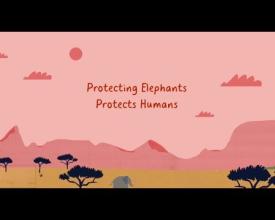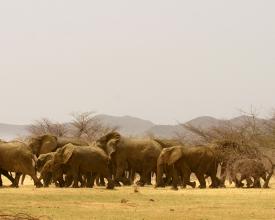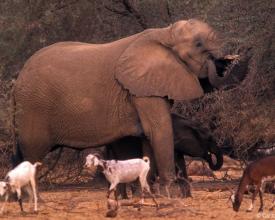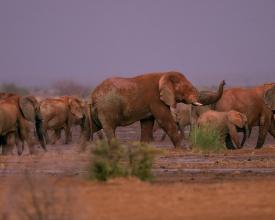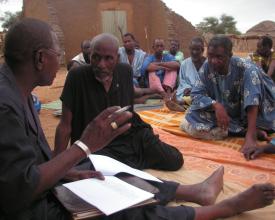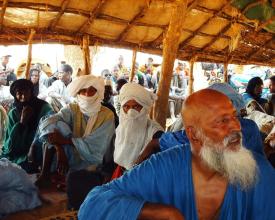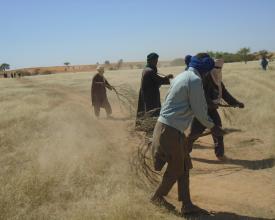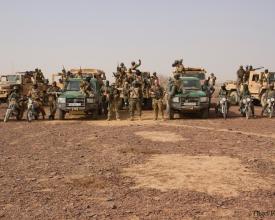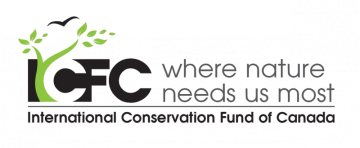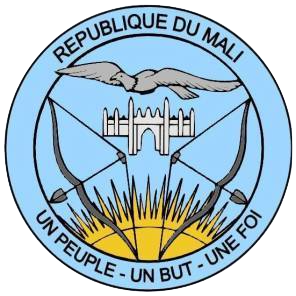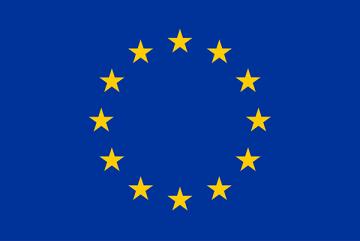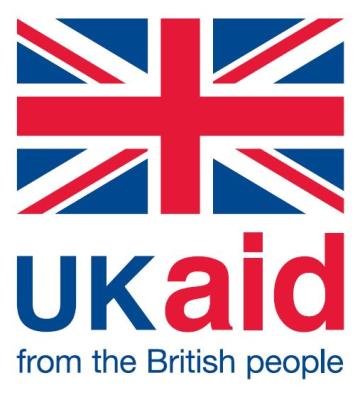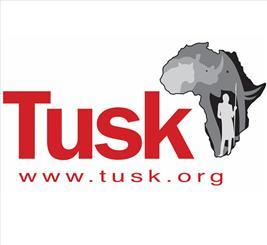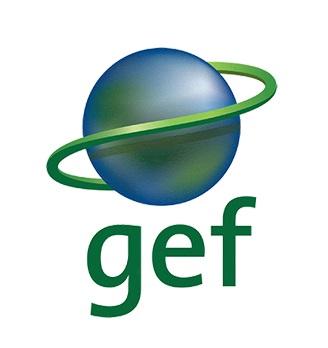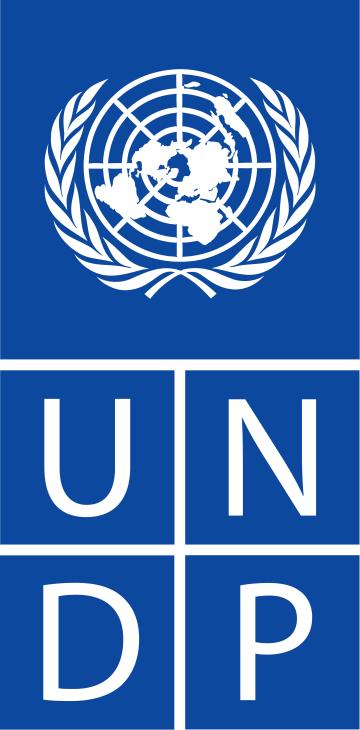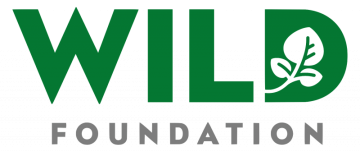
Nature recovery through community-owned natural resource management: a path to ecological and social resilience
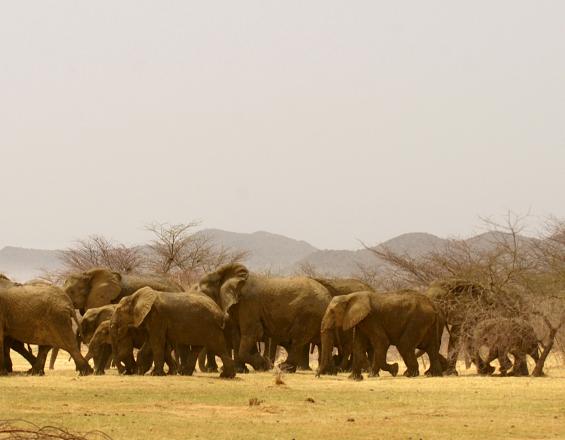
The Mali Elephant Project applies an integrated, landscape-level approach to the complex problem of human wildlife coexistence across 42,000km2. Based on the multiple values that local actors associate with the presence of elephants, the project works simultaneously at multiple levels, using a participatory approach with stakeholders to co-create solutions that protect one of the last remaining elephant populations in West Africa. Human-induced habitat loss, environmental degradation, conflict and poaching threaten both the elephants and local livelihoods. To combat these, the project supports the local communities of the elephant range in the establishment of community-centred natural resource management systems that protect natural habitat and reverse environmental degradation. A healthier environment supports local livelihoods, provide occupations for at-risk youth and revenue-generation opportunities, particularly for women. These systems also build social cohesion and reinforce local support for elephant conservation.
Context
Challenges addressed
- Lawlessness, conflict and insurgency by extremist groups
- Communities impotent to prevent habitat loss and ecosystem degradation resulting in impoverished subsistence livelihoods
- Over-exploitation by burgeoning cattle herds and other commercial interests from distant urban centres
- Social tensions between clans and ethnicities over access to natural resources resulting in no collectively respected management systems
- Elephant poaching as the project area lies astride major international trafficking routes
- Unregulated hunting leading to the disappearance of many wildlife species
- Increasing human-elephant conflicts as elephants are displaced from their refuges by armed groups occupying dense thickets surrounding waterholes, coupled with the impacts of artisanal gold-mining
- Youth unemployment and vulnerability to recruitment by armed groups
- Lack of economic/social empowerment of youths and women
- Lack of Government capacity with regard to elephant protection and protected area management
Location
Process
Summary of the process
All the building blocks are intimately linked and derive from the first building block, the project’s “complexity” perspective which sees the problem as emerging from the relationships of its wider context between people and between people and nature. Guided by a vision of peaceful human-elephant coexistence, it finds ways to reinforce positive aspects and resolve negative relationships by careful action. It requires an open mind to respect the perspectives of all stakeholders; fill knowledge gaps; identify and network “assets” and key intervention points for action. It involves facilitating the co-creation of a common perspective among stakeholders, followed by transparent and just solutions at grassroots level, further “enabled” by new legislation (e.g. the new Gourma Reserve). Ongoing dialogue and learning between stakeholders is central. The ripple effects go beyond pure elephant conservation, becoming a driving force for improved ecological and social resilience. Taking a wide-lens view of the problem and focusing on the relationships within the social and ecological ecosystem provides more opportunities for creative solutions, as for example, by providing an occupation for at-risk youth in natural resource protection and land restoration.
Building Blocks
Applying a complex-systems approach to address a conservation challenge results in improving multiple SDGs
No species exists in a vacuum. A myriad interacting forces come into play to shape their fate, at levels that go far beyond their direct ecological environment. Recognising this means shifting the focus from the species alone to englobe the entire system (ecological, social, political, economic) in which they live. It also implies accepting the uncertainty that arises from these interactions “that simultaneously affect, and are shaped by, the wider system” (Canney, 2021). This means preconceived solutions have very little, if no, chance of truly succeeding.
Not knowing what to do forced the project to ask, observe and listen, letting the answer be shaped by the context. Over the years, it has meant understanding the social-ecological context to identify key intervention points where small inputs can have relatively large impacts, “planning for a greater degree of flexibility in responding to the unexpected, seizing opportunities, and adapting to changing circumstances” (idem), and working at different levels and with a variety of stakeholders to achieve objectives. While the initial focus was on elephants, this approach has in effect delivered multiple benefits and contributed to improving many problems at once, from ecosystem degradation to compromised livelihoods, youth unemployment, local governance and social conflict.
Enabling factors
Taking the time to truly understand and internalise complex systems theory and seeking to identify how simple, “controllable” solutions have unforeseen consequences when applied to complex situations.
Taking the time to build ecological and social literacy.
A focus on networks, connection and dynamics rather than individual entities and simple cause and effect.
A preliminary period of studying the problem in its wider context.
A host organisation (WILD Foundation) that was willing to support an unconventional (and therefore risky) approach to conservation.
Lesson learned
Be ready to not have the answer and acknowledge that you do not know what to do.
Continually question why a phenomenon appears and seek the ultimate causes.
Seek understanding from a spectrum of disciplines, perspectives and individuals and recognise that they are all partial interpretations.
Respect everyone, even those acting against you.
Be flexible, adapt to the local situation - if an approach doesn’t work, seek why, keep trying until you find the solution. In dynamic environments solutions will need continual review.
If you want someone to do something, create the context that encourages that action, so you won’t have to be expending resources on enforcement.
Be very transparent and honest in your motivations and expect the same of the people you work with to build trust. Act from genuine motivations and be guided by the local context rather than “blue-print solutions”.
A balance of multiple disciplines and complementary skills on the team. In this case the Director was from a natural science background with some social science experience, while the Field Manager was a social anthropologist with some appreciation of natural science.
Using a truly co-creative and locally adapted approach to community and stakeholder engagement and governance
The project’s approach to community engagement is always to listen first, understand local problems and preoccupations, and discuss the issue of elephants within this context. Recognising all perspectives and developing a common perspective of the problem is a key first step. Identifying the parameters of the problem and the common vision is the next step. By then, asking communities to devise a solution, with the MEP as a stakeholder, builds their trust and imparts ownership, thereby fostering sustainability.
It implies a lot of unknowns, requires flexibility and a readiness to learn, but means that initiatives are a lot more likely to succeed because they rely on existing local knowledge and knowhow, and are automatically validated and adopted by participants from the start, essential elements to building locally adapted and therefore robust/resilient solutions.
The process involves the active participation of the communes’ mayors and the government’s technical services, whose role is to support communities in the implementation of local initiatives and their integration with commune development plans. All have to demonstrate their commitment if project activities are to go ahead. This strengthens local governance by empowering all stakeholders to take responsibility for the management of their natural resources together.
Enabling factors
Mali's decentralisation legislation places the management of natural resources in the hands of local communities.
Approaching the issue with an open mind, without a preconceived solution; allowing the solution to be shaped by the local context and to emerge from an open dialogue with the local communities was key for establishing trust and collaboration.
Putting together a local team originating from the area, with a genuine understanding of local customs, culture and their subtle variations, and strong facilitation skills is one of the project’s strongest assets.
Lesson learned
Land (habitat and biodiversity) use is the key problem in these environments.
Such an approach ensures community buy-in and trust which are essential to long term success.
It was daunting to engage local communities in case they decided against elephant conservation, but it was the only way to devise a sustainable solution and it turned out that the large majority valued the elephants.
It is important that the local team be from the area, passionate for the cause. They may not be the most qualified but their ability as facilitators is the predominant quality for success along with genuine motivation and trustworthiness.
It means building their capacity in other areas, which may take longer, but is better than taking qualified people from elsewhere and grounds their contribution locally even more.
People may say things that they perceive to be most advantageous for them – even more reason to have local facilitators. It has also meant that the project has been able to continue despite extreme lawlessness.
Local communities were excited about the long-term vision of restoring the ecosystem and wildlife that had been lost.
“Elephant-centred” community-based natural resource management (CBNRM) as peace-building.
‘When you eat around a fire after a day of working together building fire-breaks, you realise we all have the same problems’.
In a context of limited resources, accommodating different livelihood practices (pastoralism, agriculture) that often come into conflict requires dialogue starting at the base. This is why the project acts as facilitator to help bring together the diverse clans and ethnicities of the elephant range to achieve unity towards a common goal – in this case the preservation of their natural resources and the regeneration of their ecosystem.
By coming together to address an environmental challenge communities benefit on multiple levels, which incentives them to collaborate further. The result is an altogether more resilient solution that is bigger than the sum of its parts. Benefits include healthier habitats; more abundant natural resources; increased food security and resilience in the face of adverse events; additional income; social empowerment incl. for women and youths; better social cohesion between and within communities; increased physical security as youths are provided with a locally respected occupations as ‘eco-guards’, which reduces the likelihood of them emigrating or joining armed groups; pride in their ability to contribute to their household and community, and exert some agency over their lives.
Enabling factors
The local people’s positive attitudes towards elephants and their understanding that they all shared the same problems provided the unifying factor around which to start.
Unemployed youth seeking a role plus degraded habitats and land requiring protection and restoration.
Lesson learned
Conflicts between humans and wildlife have conflicts between humans at their heart. It is therefore important to understand who benefits and who loses and what the power relations are, for example.
Local unemployed youth seek a role that contributes to their families and community and is respected locally. This is more important than money. They are, therefore, a great resource. Engaging them, giving them meaning and purpose, can be a powerful tool (e.g. acting against recruitment by armed groups). Any initial rewards can be for “recognition”, not a salary, which provides the means for further development under their own efforts.
It is important to first discuss the role of ecoguards and identify the qualities required before asking the community to nominate individuals.
Building a network of partnerships and aligning interests around a common vision - Don’t go it alone.
Adopting a “complex-systems” approach meant mobilising all stakeholders in the elephant range around a common vision – the preservation of the Gourma elephants, a national and international heritage. This meant holding engagement workshops with each (government administration and technical services, tourism industry, schools, projects, programs and NGOs operating in the area) to understand their perspectives, and design impactful outreach materials and activities (including a schools program). It also meant engaging and coordinating the support of other institutions in-country (e.g. foreign embassies, MINUSMA, UNDP) to deliver.
At national level this has included working with government to draft an elephant management plan; create a mixed (forester-military) anti-poaching unit and engage expert anti-poaching trainers from Chengeta W.; and create a new protected area that covers the whole elephant migration route, using a biosphere reserve model. Multi-use zones are governed by local CBNRM conventions with foresters providing supplementary enforcement if required, thereby strengthening the community systems. This aligns government and community interests to mutually reinforce each other and provide a cost-effective approach to reserve management. This top-down approach complements the bottom-up approach of community engagement.
Enabling factors
Using the elephants as a unifying factor for all stakeholders
Cultivating local partners who were able to gather the required local information and identify the relevant actors.
Identifying individuals holding key positions within relevant ministries who support the project; and bringing them together in mutual support.
A partner organisation that would pay core salaries enabled the project to raise funds and “take-off”.
Lesson learned
Although working with multiple partners takes time and can be challenging, the results are far more sustainable and resilient because every party has a stake in the process, and hopefully derives some benefit.
The scope for trade-offs was greater than initially anticipated.
Maintaining government stakeholders engaged, in particular when the government is highly dysfunctional, may require continuous effort, but is essential to building national capacity and ownership.
Individuals in key positions can greatly hamper or facilitate activities. A complex systems approach can be used to seek to understand the “landscape of power” to find ways to limit their impact, for example by finding indirect ways for obstructive behaviour or malpractice to be made public.
Community resource governance in support of protected area and landscape planning (top-down/bottom-up synergy)
MEP used Mali’s decentralisation legislation to create, with local people, a model of “elephant-centred” CBNRM. This legislation performed a vital enabling function that resulted in a model of resource governance at the village and commune levels, that was enshrined in local and commune conventions, as well as the commune socio-economic development plans. The MEP then worked with government to further reinforce these systems by drafting new legislation that created a new protected area covering the whole of the elephant migration route using a biosphere model which supported the community conventions. The aim was to give a mandate to the government foresters to be able to support local communities in the enforcement of their conventions if need be, thereby strengthening the community systems. This aligns government and community interests to mutually reinforce each other and provide a cost-effective approach to reserve management. This top-down approach complements the bottom-up approach of community engagement.
Enabling factors
The model of “Elephant-centred” CBNRM that had been devised.
Lesson learned
The importance of enabling legislation to catalyse grass-roots empowerment.
The need for a neutral “facilitation” agency to bring the different parts of the community together.
The speed of the process of creating new legislation is lengthy and depends on the degree to which government partners are engaged and championing the initiative, however NGOs can provide technical support and reminders to generate forward motion.
Impacts
The project’s integrated, landscape approach has meant that while the initial focus was on elephant conservation, the resulting method has delivered multiple outcomes that contribute to several SDGs.
Communities feel empowered to improve their well-being through taking responsibility for the management of the natural resources that are the basis of local subsistence livelihoods. This gives them ownership.
“If elephants disappear it means the environment is no longer good for us.”
This has resulted in environmental restoration and regeneration, healthy and viable habitats for elephants and other wildlife.
Other benefits include improved livelihoods, local governance (at commune and village level), social cohesion, occupations for youth, opportunities for women; and a way to resolve human-elephant conflict.
All these build environmental and social resilience, reinforcing support for elephant conservation among local communities and commune administrations, and these local conventions become an integral part of the social and economic development plans of the 16 relevant communes.
Working with Government has resulted in an elephant management plan; the creation of a new protected area covering the 42,000km2 elephant range, including enforcement mechanisms; and the creation of Mali’s first anti-poaching unit which, supported by community trust and support, prevented the elephants’ extermination.
Beneficiaries
The main beneficiaries are the local communities of the Gourma and the government of Mali. As a national and international heritage, the conservation of the iconic Gourma elephants also benefits the people of Mali, West Africa and the world.
Sustainable Development Goals
Story
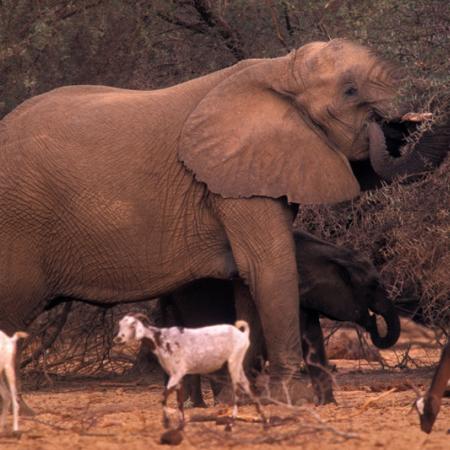
When the MEP began in 2003 increasing human pressure had resulted in habitat loss and degradation, reduced environmental and social resilience and impoverished livelihoods that exacerbated social and human-elephant conflicts.
Attitude surveys revealed that local people did not want elephants to disappear: they understood that elephants were a sign of a healthy ecosystem and that human activities must respect environmental limits. Further studies and consultations revealed more about the underlying drivers, communities’ problems, value systems and relationship with elephants. Anarchic natural resource use was at the core and individual groups were unable to act against it. It meant that Mali’s decentralisation legislation was an appropriate tool to help build consensus among the diverse local groups on resource management systems that enabled the restoration and sustainable use of natural resources for the benefit of people and elephants.
These “elephant-centred” CBNRM systems involved creating community structures: committees of elders supported by young, unarmed community ecoguards, selected by each community to patrol and enforce community agreements, as well as conduct resource protection, restoration activities, and raise local awareness.
Community rules protected their resources (water, pasture, forests, wildlife) from overuse and declared protected forests and pasture reserves, protected with firebreaks built by the ecoguards. That year, as the dry season advanced and fires broke out, their pasture survived. They had plenty of pasture for their livestock at the end of the dry season and could sell hay and grazing access at a good price to others. Their cattle were worth 50% more at market, had more young and less disease. The women were able to establish local enterprises based on the availability of natural resources, e.g. the sale of hay, forage and forest products such as Gum Arabic. These activities also promoted harmony within the community and helped heal tensions between ethnicities.
Community rules included the sharing of benefits, thus reinforcing local support for elephant conservation. As elephant poaching appeared with the advent of conflict and lawlessness community ecoguards monitored elephants, poaching and HEC. When poaching escalated in 2015, they asked for government anti-poaching support. The MEP worked with the government to create an anti-poaching unit for the Gourma; and to create a new protected area over the elephant range using a biosphere reserve model.
